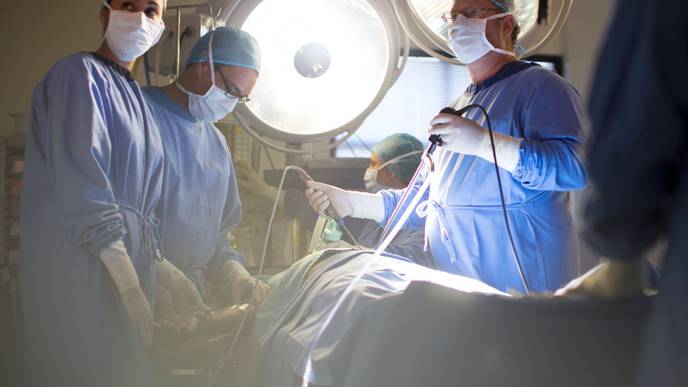Primary Surgery vs Radiation in Oropharyngeal Cancer: Does One Come Out a Winner?

07/18/2023
MONTREAL -- A study that looked at surgery versus radiation therapy (RT) for oropharyngeal cancer treatment found pros and cons with both approaches, but ultimately, surgery seemed to be the better bet.
Patients with T1-T2 oropharyngeal squamous cell carcinoma (OPSCC) in a database underwent primary transoral robotic surgery (TORS) versus primary RT and/or chemoRT (RT/CRT), according to Dev Amin, MD, of Thomas Jefferson University Hospital in Philadelphia.
Amin, who presented the findings at the American Head & Neck Society (AHNS) annual meeting, and colleagues reported that "primary TORS was associated with a clinically meaningful increased risk of short-term dysphagia." However, "[p]atients treated with primary RT/CRT had an increased risk of short- and long-term gastrostomy tube dependence and worse 5-year overall survival [OS] than those who underwent surgery," they wrote inJAMA Otolaryngology-Head & Neck Surgery.
Specifically, primary TORS was linked with a clinically meaningful increased risk of dysphagia at 6 months (OR 1.37, 95% CI 1.01-1.84) and 1 year posttreatment (OR 1.71, 95% CI 1.22-2.39) versus primary RT/CRT. And those who got surgery were less likely to be dependent on a gastrostomy tube at 6 months (OR 0.46, 95% CI 0.21-1.00) and 5 years posttreatment for a -0.05 risk difference ( 95% CI -0.07 to -0.02).
"Outcomes were indexed to occur after instance of treatment; therefore, gastrostomy tube placement should largely have captured reactive rather than prophylactic tube placement," the researchers explained. "The increased risk of gastrostomy tube placement at 5 years post-treatment in the radiochemotherapy cohort is rarely reported, given that most reports characterize 2-year post-treatment outcomes as long-term data."
"Findings of gastrostomy tube dependence at the 5-year interval highlight the importance of consideration of very late-stage toxic effects, such as radiation fibrosis to crucial swallowing structures related to chemoradiation. Initial severe late dysphagia events can continue to occur beyond 5 years after treatment," they stated. "Importantly, these events, such as fatal aspiration pneumonia, are likely contributing to late noncancer deaths that have been reported in association with other head and neck cancers."
AHNS attendee Pierre Lavertu, MD, of Case Comprehensive Cancer Center in Cleveland, commented that in his practice, "I treat with both radiation and surgery."
Lavertu, who was not involved in the research, said that "I think this study would have benefitted from inclusion of a third group of patients who received both treatments." Amin responded that a combination-treatment group was not possible given that the retrospective study used population-level data from TriNetX.
AHNS session co-moderator C. Burton Wood, MD, of Baptist Memorial Hospital in Memphis, Tennessee, noted that "I think the majority of patients that have surgery, there will be some feature in their anatomy that would dictate they need radiation as well."
Wood told MedPage Today that "I...agree with Dr. Lavertu that this is a very big, outstanding question in this study -- we need to know the rate of needing feeding tubes, etc. for those patients that have both surgery and radiation."
Patents underwent primary TORS or RT/CRT in 2002 to 2022. After propensity matching, 726 met inclusion criteria. In the TORS group, 50% received primary surgery, while in the RT/CRT group, 50% got primary RT/CRT. Data analyses were performed from December 2022 to January 2023.
Patients in the TORS cohort had a mean age 68.5, 79% were men, 86% were white, 58% had cardiovascular disease (CVD) and 31% had a history of nicotine dependence. In the RT/CRT group, mean age was 68.8, 79% were men, 88% where white, 59% had CVD, and 29% had a history with nicotine.
The researchers reported that among patients with OPSCC who were unmatched for cancer stage or human papillomavirus (HPV) status, those who received RT/CRT had worse 5-year OS versus those who underwent primary surgery (70.2% vs 58.4%, HR 0.56, 95% CI 0.40-0.79). But Amin's group cautioned that they were "unable to match patients for HPV tumor status or N stage because of the limitations of the TriNetX platform."
Still, "the current study sample comprised patients with both HPV-mediated and HPV-negative OPSCC...The results favoring TORS for OPSCC management are likely skewed by the nonradiosensitive HPV-negative OPSCC population. More RCTs [randomized controlled trials] are required to elucidate survival rates in patients with HPV-mediated vs HPV-negative OPSCC treated with TORS vs RT/CRT."
Ed Susman is a freelance medical writer based in Fort Pierce, Florida, USA.
Disclosures
Amin disclosed no relationships with industry. Co-authors disclosed relationships with Rakuten Medical and Cortexyme.
Primary Source
JAMA Ototlaryngology-Head & Neck Surgery
Source Reference: Amin D, et al "Differences in functional and survival outcomes between patients receiving primary surgery vs chemoradiation therapy for treatment of T1-T2 oropharyngeal squamous cell carcinoma" JAMA Otolaryngol Head Neck Surg 2023; DOI: 10.1001/jamaoto.2023.1944.

Facebook Comments